With a purchasing power of more than $450 billion in the United States alone, Gen Z’s buying habits are shaking up the global retail landscape. And honestly, it’s no surprise looking at my younger cousins, nieces, and nephews.

Although many Gen Zers are still coming of age — earning their first allowances and paychecks, entering college, or just joining the workforce — they are already influential players in the market.
They have their own smartphones and debit cards. They impact trends, slang, and even purchases made by their seniors.
(Who do you think tempted me to buy a Squishmallow of my very own? It certainly wasn’t anyone at the office.)
They are a force to be reckoned with, and as a marketer, you need to be aware of their ways and ready to adapt to them.
Gen Z’s Spending & Shopping Habits in 2024
In 2022, Afterpay’s Next Gen Index predicted that Gen Z will account for 17% of total spending in the U.S. by 2030. That’s a healthy 12% jump from where it stood that year.
And as Gen Zers mature, that number will only increase.
However, studies show Gen Zers shop and spend money very differently from their Millennial predecessors.
While Millennials and past generations were loyal to brands, Gen Z is more interested in shopping around and prioritizing value. They’d rather browse multiple brands at department stores than one at a flagship store.
Marketers must keep an eye on these differences and other Gen Z buying habits. Let’s dive into some of the biggest.
HubSpot uses the information you provide to us to contact you about our relevant content, products, and services. HubSpot will share the information you provide to us with the following partners, who will use your information for similar purposes: Glimpse. You can unsubscribe from communications from HubSpot at any time. For more information, check out HubSpot's Privacy Policy. To unsubscribe from Glimpse's communications, see Glimpse's Privacy Policy.
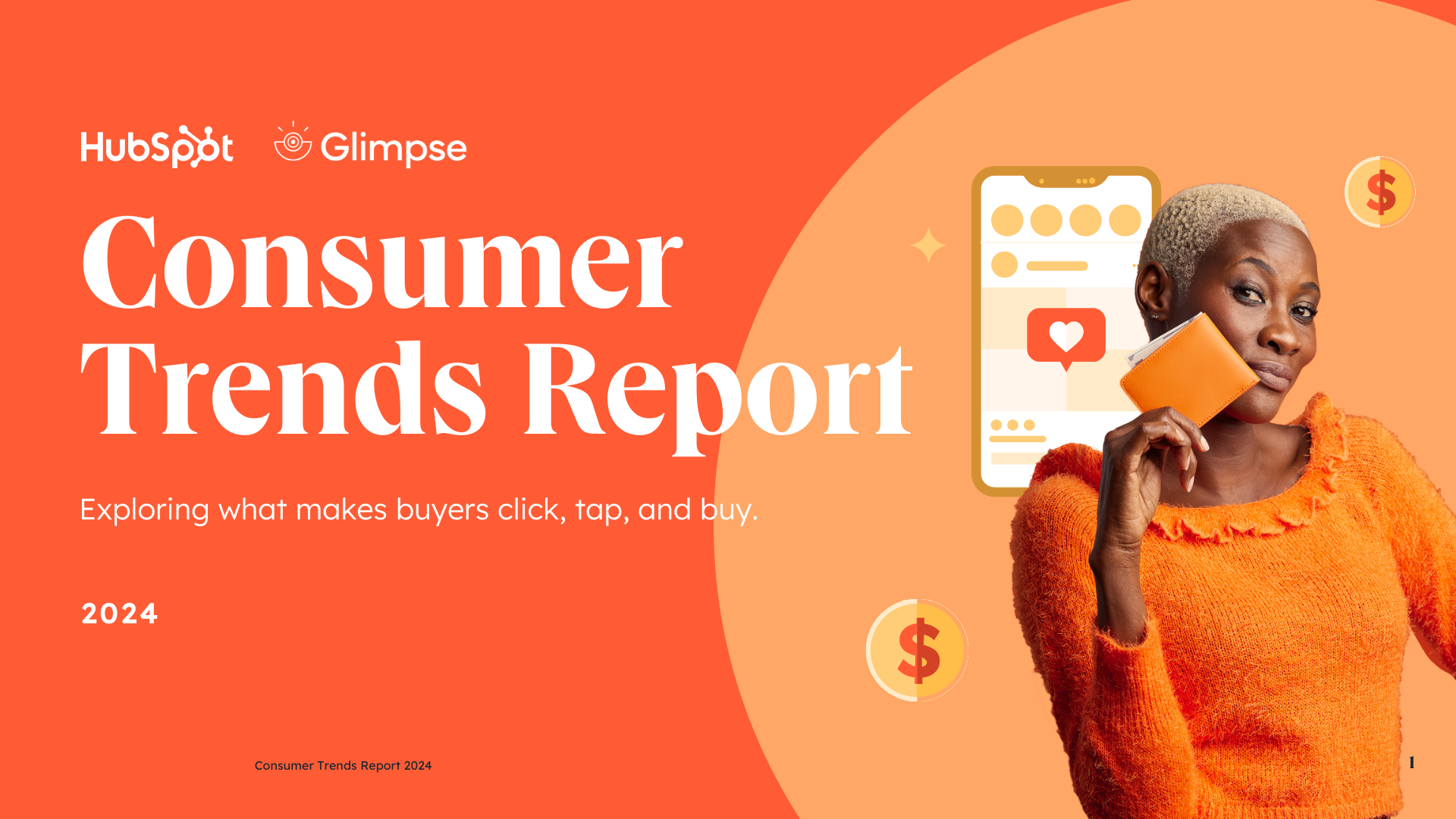
U.S. Consumer Trends Report
Learn how consumers act, how they think, and what they expect now and beyond. Topics include:
-
Purchase habits.
-
Data privacy.
-
Workplace trends.
-
And more!
1. Acting Mobile First
This likely comes as no surprise, but Gen Zers are glued to their phones when it comes to shopping. In fact, our 2024 Consumer Trends Report revealed that 71% of those aged 18-24 go mobile first for shopping.
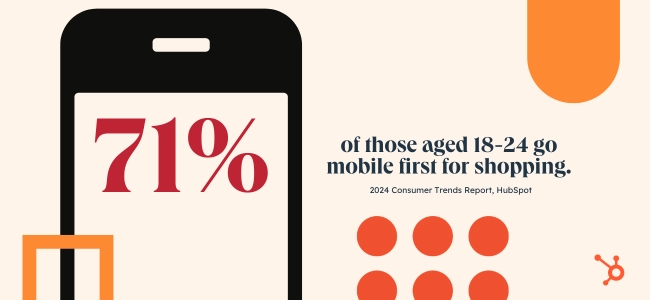
That includes visits to dedicated retailer websites, review sites, and social media — but more on that shortly.
Not only does the majority of Gen Z turn to mobile for researching or making purchases, but they’re also making mobile payments.
Yes, 52% of Gen Zers use debit cards as their first payment option. But according to SurveyMonkey, one in three also reported using Venmo, Apple Pay, or the Cash App for purchases last year.
However, this doesn’t mean they spend as casually as they scroll.
Studies from Attentive show Gen Z only feels comfortable spending $20-50 in mobile transactions. For purchases with a higher price tag, they prefer to shop in person so they can know exactly what they’re getting.
(Quite practical of these young folks, wouldn’t you say?)
What should you do as a marketer? Make sure your website and any digital touchpoints are optimized for mobile browsing. Also, consider offering mobile payment options for products or services that can occur digitally.
When it comes to big-ticket purchases, explore how to enable customers to “try before they buy” through a free sample or trial. This first-hand experience can dramatically mitigate objections or fear of buying.
2. Turning to Social Media
Where there’s a smartphone, social media can’t be far behind.
We found that social media is the #1 channel for product discovery for Gen Z (along with Millennials and Gen X) — and who’s surprised given the number of products on explore feeds, user-generated content, and sponsored posts?
All these options aside, Gen Z’s preferred mediums for finding new products are short-form videos or social media marketplaces like Facebook Marketplace.
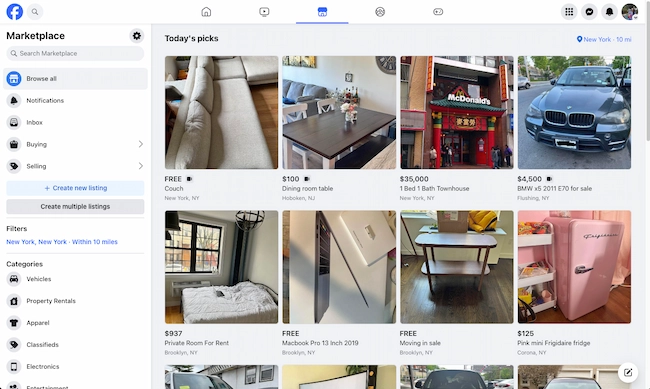
Our research also showed TikTok is their favorite place to hang out (which makes sense with their love of short videos), followed by Instagram and YouTube.
However, SurveyMonkey found that most actual product research is done on YouTube.
But does all social media fun translate to real sales?
Despite their love of social media research and leisure, SurveyMonkey surprisingly found that 67% of Gen Zers have not actually purchased an item directly on a social media platform. That behavior is more popular with Millennials.
What should you do as a marketer? Explore different ways to get your product on social media feeds. Popular options include creating and sharing short video content, using paid ads, encouraging user-generated content, and working with influencers.
If you’re a HubSpot user, Content Hub features like Social Inbox and Content Remix can help execute social strategies like these to reach Gen Z.
3. Trusting Influencers and Creators
As hard as it may be to hear, we found that Gen Z feels recommendations from influencers are more significant than those from friends and family.
(I’ll pause for a moment of heartbreak with my fellow cool aunts.)
This finding is supported by SurveyMonkey’s that 58% of Gen Z have actually bought something based on an influencer’s recommendation. This is the highest of all the age groups and, truthfully, the appeal is understandable.
Consumers generally follow influencers and creators because they can relate to them. Perhaps they come from a similar background, have the same interests, or have some expertise in an area their followers aspire to grow.
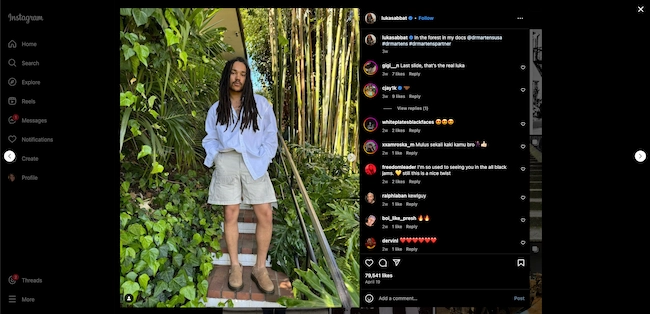
With over 4 million followers, Lukas Sabbat is a popular influencer turned actor among Gen Z. He also partners with brands like Dr. Martens.
Whatever the reason, a great influencer comes to their audiences with authenticity and a unique perspective. In turn, followers tend to have faith in them to share sound advice and recommendations.
This level of trust is powerful. At the end of the day, no one will buy from you unless they trust they’ll get their money’s worth.
So, if you can work with an influencer who your buyers already know and love, your barrier to making a sale is far lower.
What should you do as a marketer? Dive into which influencers and creators your Gen Z buyers follow. Are they relevant to your brand or offering? If so, consider how you can partner with them to get in front of your target market.
You could simply send them a free product to post about or collaborate on a specific campaign.
Learn more about your options for influencer marketing.
4. Prioritizing Sustainability
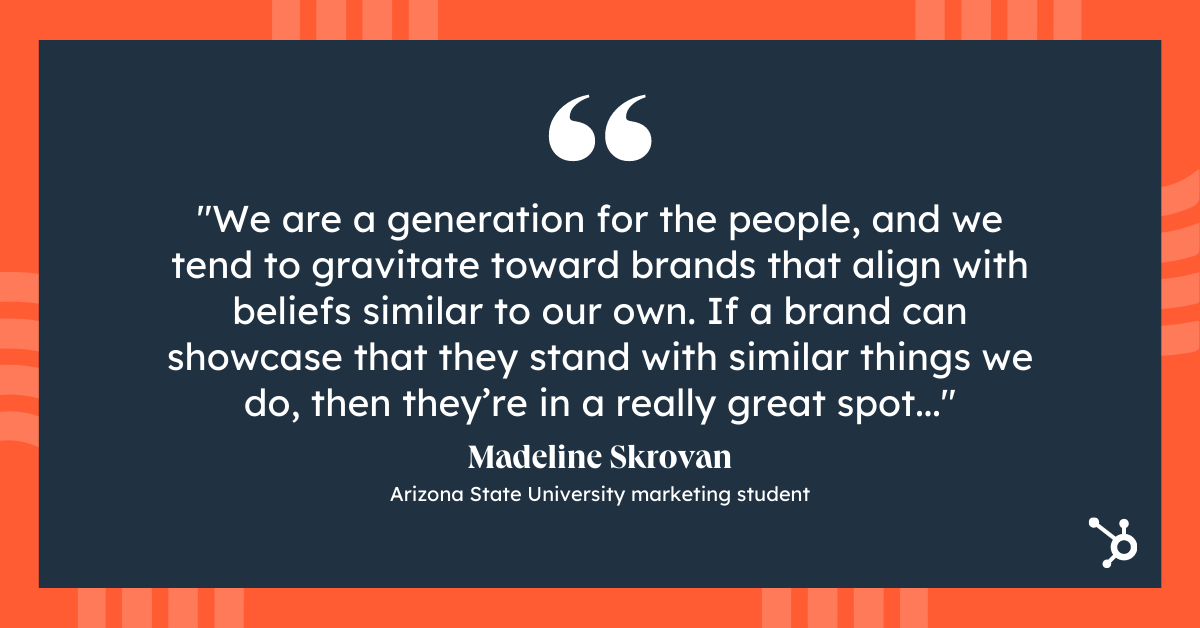
Gen Z is known to shop its values, but one specifically stands out today: Sustainability.
In the age of climate change and fast fashion, EY and JA Worldwide found that Gen Z (and Gen Alpha) are better educated on sustainability and environmental issues than any previous generation — and it shows.
They champion reusable water bottles (read: the Stanley cup hype), tote bags, and second-hand buying.
In fact, eBay recently reported that 36% of Gen Z second-hand purchases are specifically out of concern for sustainability and the environment.
@victoria_robino_26 #fyp #fypシ゚viral #target #targetfinds #stanleycup #stanley #stanleytarget #valentinesday #stanleyvalentinesday ♬ original sound - Victoria Robino
Stanley cup popularity was heavily driven by Gen Z.
Second-hand or not, Afterpay found that 49% of Gen Zers opt to buy sustainable products when possible, while one in three even abandoned a brand in 2023 because they had a poor reputation for ethics and sustainability.
So, it pays to “go green.”
What should you do as a marketer? Look for ways to highlight how your brand cuts carbon emissions, goes paperless, or tries to be more environmentally friendly.
This could be a dedicated page on your website (like one of my favorite jewelry brands, Monica Vinader) or social media content (like this example from Patagonia).
Whatever your approach, just make sure it is genuine. Gen Z can sense performative activism from a mile away.
5. Seeking Deals and Lower Prices
Gen Z’s buying habits are evolving as they enter adulthood.
Though they once owned up to impulsive shopping habits, Gen Z is now more budget-conscious. This is likely due to inflation, a difficult job market, and greater financial insecurity.
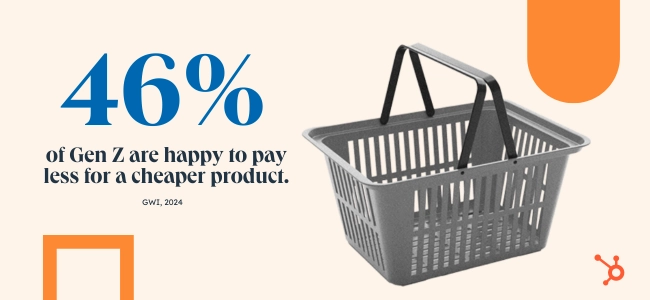
Don’t believe me? GWI found that 71% of Gen Zers would rather wait for a product to go on sale than buy full price.
Plus, 46% are happy to pay less for a cheaper product. Gen Z is trying to save like many older generations, and that goal should be taken seriously.
What should you do as a marketer? Even if you have sustainability or influencer support on your side, be smart about how you price your product.
To appeal to Gen Z, consider capitalizing on sales or incentives like free shipping, discounts, or premiums.
Customer loyalty programs are also fun ways to offer deals and keep yourself budget-friendly for Gen Z. And you usually get something in return (i.e., new customers, social media promotion) as a business.
6. Focusing on Quality
While Gen Z loves a deal, make no mistake: they are not compromising on quality.
According to SurveyMonkey, 64% of Gen Zers list quality as the most important factor when purchasing.
Furthermore, a holiday shopping report by McKinsey & Company found Gen Z was the only generation to rank quality as more important than price.

Between this and their penchant for research, reviews, and recommendations, Gen Z is clearly trying to ensure their money is spent wisely.
What should you do as a marketer? Go the extra mile to provide proof of your quality. Consumers believe in peers more than they believe in brands themselves.
So, use social proof (i.e. third-party reviews, customer ratings, testimonials) in your marketing to show that your product or service is worth the investment.
Now that you know how Gen Z is shopping, let’s examine what they’re shopping for.
HubSpot uses the information you provide to us to contact you about our relevant content, products, and services. HubSpot will share the information you provide to us with the following partners, who will use your information for similar purposes: Glimpse. You can unsubscribe from communications from HubSpot at any time. For more information, check out HubSpot's Privacy Policy. To unsubscribe from Glimpse's communications, see Glimpse's Privacy Policy.

U.S. Consumer Trends Report
Learn how consumers act, how they think, and what they expect now and beyond. Topics include:
-
Purchase habits.
-
Data privacy.
-
Workplace trends.
-
And more!
5 Things Gen Z Will Spend Money On
According to the 2023 Consumer Culture Report by 5WPR, Gen Z will “splurge” in three areas: electronics, health and wellness, and clothing and fashion.
With some additional research, we also found that Gen Z pays special attention to small businesses and education.
Let’s break down each category.
1. Electronics and Technology
Udonis found that 90% of Gen Zers identify as gamers, and many spend more time with their friends playing video games online than they do in person.
So it should be no surprise that Gen Z is willing to spend on video games and consoles. (I guess kids really don’t play outside anymore.)
As digital natives, however, Gen Z's buck doesn’t stop there. They are inclined to spend on electronics and technology in general — especially if it means having a good time or improving their daily lives.
What should you do as a marketer? Lean into how your tech can improve your buyer’s daily life in your marketing.
For example, take fitness trackers. Although some might consider a fitness tracker superfluous, Gen Z led the charge toward their popularity in 2023. While not specifically targeting Gen Z, Fitbit shows why.
The tech company positions its product as part of a “fun” and active lifestyle. On social media, it shows the fitness tracker being worn not only during workouts but also while dancing, playing with pets, traveling, and kayaking.
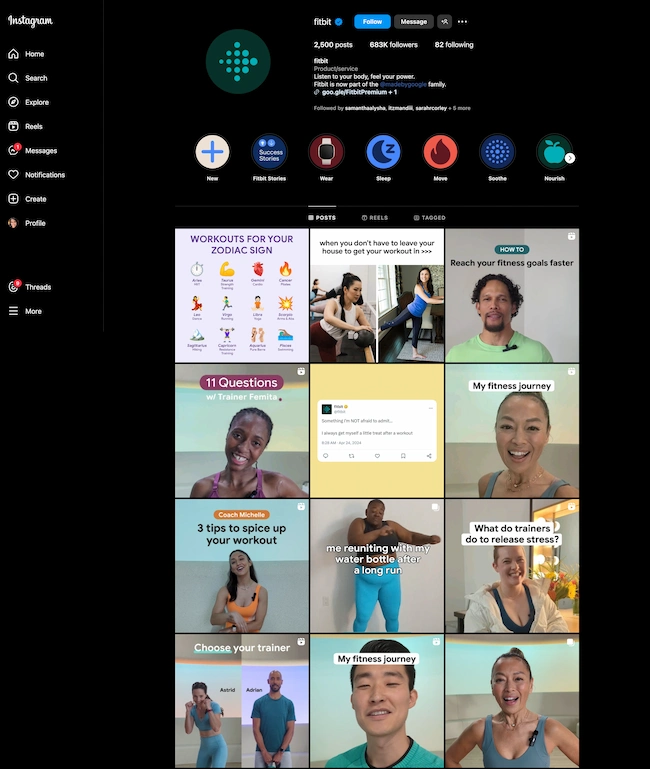
Fitbit also publishes content on its blog discussing healthy recipes, workout tips, and overall well-being.
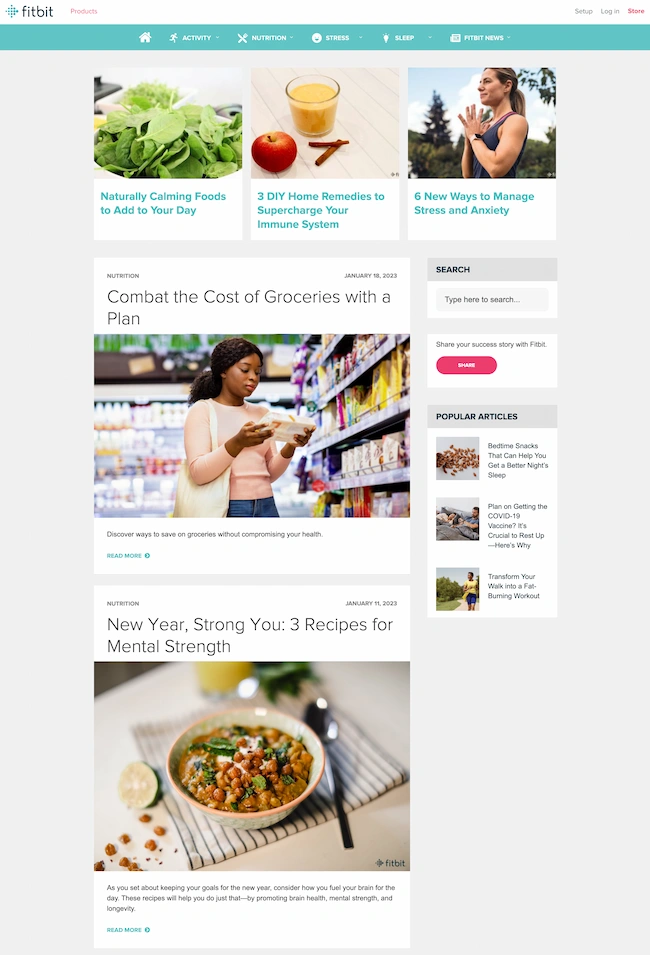
While Fitbit doesn't claim its product is necessary for health, it shows audiences how the product can help anyone track vital information and potentially live better.
When a health-conscious Gen Zer is looking for wellness advice or workout tips, Fitbit is positioned to get found, resonate, and make the sale.
(And trust me, there are a lot of Gen Zers focused on wellness.)
2. Health and Wellness
Speaking of health and wellness, that is the second highest area that Gen Z is willing to splurge on.
GWI found that Gen Z is over three times more likely than the average to say they have a mental health condition. But they’re also 12% less likely to feel comfortable talking about it.
So, it’s no wonder they are willing to invest in products that will help.
This group seems to be the leader in the modern wellness movement, promoting mental health, ethical food sourcing, skincare, and other related health topics.
WSL also reported that Gen Zers are more likely to use natural remedies than traditional medications.
What should you do as a marketer? Many brands have an excellent opportunity to normalize mental well-being and provide a solution.
For example, if your product can help someone free up more time for things they love, this positioning may help you appeal to Gen Z.
3. Clothing and Fashion
Regardless of gender, clothing is one of the top investments by members of Gen Z — but not in the same way it was for older generations.
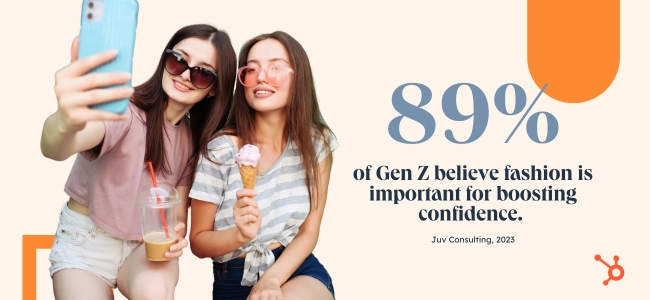
A survey by Juv Consulting revealed that 89% of Gen Z believe fashion is important for boosting confidence, while 82% say it helps showcase their identities.
“For Gen-Zers, fashion is less about being trendy or denoting status,” explain Benjamin Schneider and Diana Lee at Business of Fashion.
From Barbiecore and Dark Academia to Coastal Grandma, Gen Z is leaning into “aesthetics” showcased on social media.
Then, in Schneider and Lee’s words, they "adapt pieces representative of trends into their own personal styles, as opposed to following trends full-scale.”
What should you do as a marketer? Monitor what aesthetics are trending and explore ways your brand may align with them.
If you’re a clothing brand, this is easy. But even if you’re not, you can still engage and appeal to Gen Z with some creative content.
For example, take the surge in popularity of “The Tortured Poet’s Department” aesthetic inspired by the Taylor Swift album of the same name.
Craft store Michael’s leaned into the trend by posting a video on TikTok highlighting different products on its shelves that could be “found in the department.”
@Michaels Stores It’s giving all the decor you need for your poetic era
♬ Promoted Music - Michaels Stores
Similarly, Lilly’s Library — an Instagram-based book club run by South Asian actress and YouTuber Lilly Singh — shared book titles that aligned with themes of different tracks from the Swift album.
Both approaches effectively brought each brand’s offering into the conversation but allowed the brand to stay playful and “on trend.”
4. Small Businesses
In 2022, we found that 60% of Gen Zers chose a product because it was made by a small business.
Simultaneously, Afterpay’s Next Gen Index noted small business spending had increased more than 300% for Gen Z on Afterpay. In fact, almost two-thirds of all spending on small businesses at the time came from Gen Z and Millennials.

That drive is still present.
Earlier in 2024, we ran a follow-up survey and found that supporting a small business has more weight in a purchase decision for Gen Zers than any other generation.
This continued effort could stem from the COVID-19 pandemic, as many small businesses struggled to survive and faced unexpected layoffs.
Gen Z loves that small businesses can develop personal connections with their consumers and contribute to their local economies.
Another interesting revelation is that consumers are more willing to share their data with small businesses in exchange for discounts and deals. They think they are more transparent about how their information will be used.
What should you do as a marketer? If you are a marketer at a small or local business, embrace your size! Your small but mighty footprint is one Gen Z wants to support.
Be transparent about your company and what’s happening behind the scenes. Share your origin story. Introduce your team and show buyers where their money is going. Many, especially Gen Z, will appreciate and often reward the authenticity.
5. Education
Gen Z is on track to have the highest level of education among generations, surpassing even millennials, and with good reason. Jobs are becoming more competitive, so having a graduate degree is becoming more common.
In response, Gen Z appears to have started saving for college at a much younger age than millennials, but their investment extends beyond just formal education.
This includes online courses or educational programs to help advance their careers, too.

In the 2024 LinkedIn Workplace Learning Report, it’s revealed that 53% of Gen Zers believe learning can help them explore career paths. That’s 16% more Millennials, Gen X, and Baby Boomers combined.
What should you do as a marketer? First off, always consider what kind of education you can offer your audience. Providing educational value is a staple of content marketing. Think about how you can teach potential buyer’s what they don’t know about your product, service, or industry.
A great example is HubSpot Academy. In HubSpot Academy, we offer hundreds of free resources to help anyone learn how to market and grow their businesses online whether they use our platform or not.
If you can’t educate (perhaps there are legal or safety limitations), you can still reach Gen Z or anyone who cares about learning by appealing to these values in other ways.
Consider how your product could help or benefit the experiences of someone planning for college, college students, or young professionals.
For example, if you're marketing furniture, you could create a promotion highlighting products that fit in an apartment or dorm room.
Or, if you market clothing, you could underline items that could be worn in a job interview in a blog post on your website.
Even if you can’t necessarily expand the knowledge of your consumers, there are still ways to meet them where they’re at emotionally.
How to Market to Gen Z Based on Their Spending Habits
As a marketer, hearing about these shifts in buyer behavior and mounting studies might make you nervous.
But, truthfully, the consumer trend of putting value first shouldn't scare or shock you. It should motivate you to ask, “How can I provide better value to my customers?”
Although Gen Z might seem more budget-conscious, this doesn’t mean they won’t buy anything from you.
Many of your most frugal prospects will still shop if your offering seems valuable, can help them solve pain points, or provides a positive, memorable experience.
Ultimately, bettering your brand, focusing on the customer experience, and promoting positive company reviews will go a long way with Gen Z (and all other audiences).
With these tips — and by keeping your eye on the ever-evolving market — you will be well-prepared to match Gen Z’s “aesthetic.”
Editor's Note: This post was originally published in July 2020 and has been updated for comprehensiveness.
![Download Now: The State of U.S. Consumer Trends [Free Report]](https://no-cache.hubspot.com/cta/default/53/ebf9ec8e-a468-455a-943e-80aa4e6be694.png)




![The 6 Stages of the Product Life Cycle [+Examples]](https://blog.hubspot.com/hubfs/product-life-cycle_0.webp)





